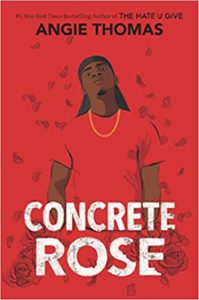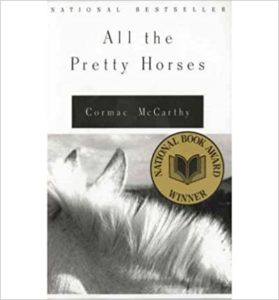On Reading Violent Stories
I can read violent stories, but I have never been able to watch them. This dates back to a particularly traumatic viewing of a filmstrip of the Hans Christian Andersen tale, The Steadfast Tin Soldier. But recently someone I love wanted me to watch a Quentin Tarantino film. He promised to tap me when I needed to look away. (There was much frantic tapping, but I already had my trusty pillow between myself and the screen.) The movie, which offered a revisionist take on history, forced me to ask good questions: If a smaller act of violence prevents a larger one, might it be justified? What is the difference between revenge and martyrdom? And what is it about violent stories that pulls us in, even when we cower?

There are readers who don’t want any violence in their stories. If that’s you, stay away from McCarthy, whose books are both lyrical and brutal. Other readers can handle some tough stuff, but nothing too graphic. I think Thomas falls into that category, since her books are for a YA audience. Both books also have beautiful passages. In Cormac McCarthy, it’s the untamed West, best seen from horseback. In Angie Thomas, it’s the love of family and friends. These elements are all the more poignant because they coexist with violence.
Some people say they want nothing to do with violent stories, yet they read cozy mysteries, which still revolve around a dead body. As I was writing this post, the sweetest friend I’ve ever known told me she chills after a hard day of teaching school to true-crime drama.
So what does it mean to approach generously our need for stories with violence? I think it’s our way of journeying to the underworld, safely.
Odysseus must visit Hades’ realm. So must Orpheus. And several characters in Tolkien’s Lord of the Rings trilogy. Maybe we don’t confront the undead, but maybe our hell is a hospital room. Maybe it’s a courtroom. Too many funeral parlors.
Most terrifying is the hell inside us. John Grady Cole must look into the “gorgon in an autumn pool,” the “maimed and raging djinn” inside his soul and decide if that is who he wants to be. Maverick, “a drug-dealin’ gang-bangin’ high school flunkout” with “two kids by two different girls at 17” must choose whether he is brave enough to finally live up to his name.
Likewise, I have had to look deep inside and decide what my response will be when I am betrayed. What harm is there in a little non-violent revenge fantasy? When does it veer into the harmful? If I go there, can I ever come back again?
I think the difference, for me, in reading about violence versus watching it is the images my mind creates. In All the Pretty Horses and Concrete Rose, no one, not even an illustrator, dictated what I saw. I can open those books right now and again be immersed in my imagined version. But I can never unsee that terrifying moment when the boy throws the tin soldier into the fire.
July’s Pages
Poetry
I’m Nobody! Who Are You?, by Emily Dickinson, edited by Edric S. Mesmer
Poems for Young People: Emily Dickinson, by Emily Dickinson, edited by Frances Schoonmaker Bolin, illus. by Chi Chung
The Headless Horseman Rides Tonight: More Poems to Trouble Your Sleep, by Jack Prelutzsky, illus. Arnold Lobel (children’s poetry, much scariness and violence implied)
Picture Books and Early Readers
Brother Eagle, Sister Sky, by Susan Jeffers
Poppleton in Fall, Poppleton in Winter, Poppleton in Spring, by Cynthia Rylant, illus. Mark Teague
The True Story of the 3 Little Pigs! by A. Wolf, by Jon Scieszka, illus. Lane Smith (Join us for Children’s Book Club next Friday, August 13!)
Middle Grade and YA
Concrete Rose, by Angie Thomas (prequel to The Hate U Give)
Grownups
The Mystery of Mrs. Christie: A Novel, by Marie Benedict
Great Expectations, by Charles Dickens (reread)
“Total Eclipse,” by Annie Dillard, essay in Teaching a Stone to Talk (hat tip Glynn Young)
Good Smoke, Bad Smoke: A Texas Rancher’s View of Wildfire, by John R. Erikson
All the Pretty Horses, by Cormac McCarthy
The Age of Innocence, by Edith Wharton
Made Progress
Love Poems from God, translated and edited by Daniel Ladinsky
Your Turn
1. Have any of your thoughts on violence shifted, over time, or even today?
2. Guess which Tarantino film I saw, based on hints in the text and this post’s photo.
3. Share your July pages. Sliced, started, and abandoned are all fair game.
Photo by Nathalie, Creative Commons, via Flickr. Post by Megan Willome.
Browse more Reading Generously
I loved this book. As soon as I finished, I began reading it again.”
—David Lee Garrison, author of Playing Bach in the D. C. Metro
- Perspective: The Two, The Only: Calvin and Hobbes - December 16, 2022
- Children’s Book Club: A Very Haunted Christmas - December 9, 2022
- By Heart: ‘The night is darkening round me’ by Emily Brontë - December 2, 2022



Glynn says
The older I get, the less I’m able to read violent stories, and the less I’m able to watch violent films and television, no matter how well done. It may be because reading offers a respite from the violence of the daily newspaper, the web, and social media. I read a lot of mysteries, with a certain amount of violence in them, but I’ll stop reading a book if it becomes too graphic and focused on violence for its own sake. Confession: I have never seen a Quentin Tarantino film, not even “Pulp Fiction.”
July reading:
Mystery (speaking of violence)
A Fatal Flaw by Faith Martin
Watching Crows by Glenn McGoldrick
The Man by the Sea by Jack Benton
The Enemy Within by Scott Hunter
Shakespeare Project
A Lover’s Complaint and The Passionate Pilgrim
A Midsummer Night’s Dream
The Merchant of Venice
Much Ado About Nothing
Poetry
Somewhere to Follow by Paul Willis
The Dark Between Stars by Atticus
Fiction
Iron Island by Gareth Griffith
The Great Gatsby by F. Scott Fitzgerald
The Weight of Memory by Shawn Smucker
Love on a Limb by Laurie Lewis
Non-fiction
Reading the Times by Jeffrey Bilbro
Live Not by Lies by Rod Dreher
The Abolition of Man by C.S. Lewis
After Humanity: A Guide to The Abolition Man by Michael Ward
Megan Willome says
Glynn, I get it, I really do.
So glad to see Paul Willis on your poetry list!
L.L. Barkat says
Great questions, Megan. If I had to choose standing strong over being violent, as a way to prevent larger violences, I would. But that gets complicated if one is being advanced upon, yes? I know I am going to keep thinking on this puzzle you’ve put before me. 🙂
So happy to see you read Love Poems From God. That’s where I got my Rabia poem inspiration from! Hers is quite a story. You could say she turned violence into poetry.
I just finished reading The Passion Economy, which I liked a lot. Business book. (You know me and my penchant for business books! 🙂 )
Megan Willome says
I haven’t gotten to Rabia yet (I’m skipping around, section by section). The book belonged to a poetry friend who passed away. So far I am really loving Hafiz.